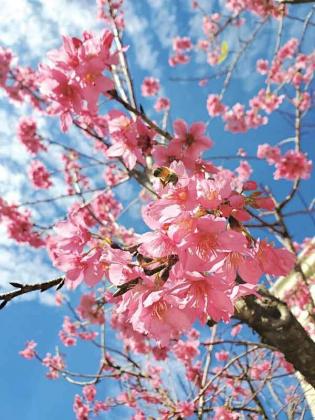
Heather Kirk-Ballard LSU AgCenter horticulturist
Flowering cherry trees are true showstoppers. These trees can be seen blooming around Louisiana in February and March. In the southern part of the state, the first flowers appear in late January. Right now, they are in full bloom on the LSU campus in Baton Rouge, and boy are they gorgeous!The attractive flowers are a vibrant, dark pink and are produced on bare branches just before leaves emerge to create a stunning show. These deciduous trees grow up to 20 feet in height and are equally as wide. They are well-suited for USDA plant hardiness zones 7b to 9a.
Flowering cherries make a great specimen, or accent, tree in the landscape. The tree form is upright, and its arching branching habit makes it perfect for lining a road or driveway.
The Taiwan flowering cherry (Prunus campanulata), Kwanzan flowering cherry (Prunus serrulata) and the hybrid Okame flowering cherry are popular varieties to consider. As the names suggest, the trees are native to Asia. Plants prefer a full- to part-sun location in the landscape. Well-drained soil is also needed for best performance.
In Japan, the cherry blossom is revered as the essence of life. According to the National Park Service, cherry trees were planted in Washington, D.C., in 1912. Thousands of trees were given as a gift to the United States from Japan. That gift included 12 different species.
The first Cherry Blossom Festival in the Tidal Basin in our nation’s capital was held in 1935. This year, it will be held from March 20 to April 11. As history goes on, the cherry trees continue to tie the relationship between United States and Japan. For more information, visit the National Park Service website at https://bit.ly/3rHAD7e.
In Louisiana, plant a flowering cherry in loose, fertile soil. Avoid compacted clay soils that can become too wet or too dry. Flowering cherries prefer a well-drained, acidic soil. You can improve the soil by amending with organic matter such as compost, and you can lower the pH if needed with aluminum sulfate or elemental sulfur. Be sure to follow the manufacturer’s label for directions and application amounts.
For the best bloom, plant in an area that gets a great deal of sunlight with light shade in the afternoon to help reduce water stress and leaf scalding. Be sure to irrigate during extended droughts.
Flowering cherries, much like other fruits, require chilling hours for a good bloom — meaning trees typically perform better in the northern part of Louisiana. Chilling hours is defined as the amount of time spent at temperatures from about 32 to 40 degrees Fahrenheit. They’re needed to develop flowers and fruit.
Luckily, the varieties recommended above have a low chill requirement. Although cherries are better suited for cooler climates, the Taiwan cherry is the most heat-tolerant of the many species and will grow fairly well here.
Flowers make way for small red fruits that attract songbirds and other wildlife. The bark is another aesthetic feature, being grayish-brown in color with light gray horizontal lenticels. Delicate, peeling bark also lends to this tree’s beauty.
Flowering cherries have a few drawbacks. First, they are short-lived trees, typically living for only 10 to 15 years. However, that is plenty of time to enjoy the blooms of these gorgeous trees. If you are lucky, dropped fruit will provide some new seedling volunteers.
The trees are susceptible to a few diseases, such as leaf spot, leaf curl, powdery mildew and fireblight. Some insect pests include borers, aphids, scale, tent caterpillars and Japanese beetles.
For the most beautiful blooms, fertilize once a year with a low-nitrogen fertilizer in the early spring. Pruning also is recommended in the early years of the tree’s life.
Examine the tree each year, trimming as needed to keep it in the shape and size you desire. Remove suckers or shoots coming off the bottom of the tree in addition to branches from the center of the tree. Be sure to remove dead or diseased branches.
Unpruned trees may become overgrown and weak. It is best to prune immediately after the tree flowers in the early spring to help promote new growth and to improve next year’s flowering display.
